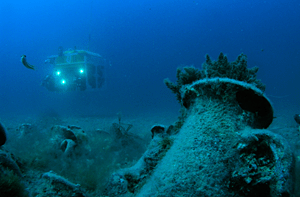
Once closed to exploration, the waters off the Albanian coast begin to give up their secrets

The SeaEye remotely operated vehicle investigates a 1,600-year-old shipwreck that contained amphorae from Tunisia.
(Courtesy RPM Nautical Foundation)
The R/V Hercules is anchored in the Adriatic Sea near Saranda, Albania, and the crew of the 110-foot-long research vessel is at attention. "Back deck, stand clear of the wind!" RPM Nautical Foundation (RPMNF) founder George Robb bellows into a walkie-talkie from his seat in the boat's control room, deep in the belly of the ship. "Winch going out, winch going out!"
Up on deck, two crew members ease the massive, million-dollar SeaEye Panther Plus remotely operated vehicle (ROV) off the stern. With two spindly arms and a boxy frame, the submarine robot resembles a cross between R2-D2 and a construction crane. The SeaEye is about the size and weight of a golf cart, but a single Kevlar cord attached to its protective metal cage holds it up and out over the water. The apparatus breaks the surface of the water, and the boat heaves from the sudden lightening of its load.
As robot and cage plunge into the Adriatic, a video feed streams from a camera bolted to the top of the cage to one of the dozen computer monitors in the sunless control room. "Give me TMS full-screen here," Robb calls out. "Is it off? Kill it and reopen it."

To read more, find ARCHAEOLOGY in your local newsstand or bookstore, or click here to buy a copy of the issue online. And if you'd like to receive ARCHAEOLOGY in your mailbox, click here to subscribe.
Mara Hvistendahl is a science journalist based in The Netherlands.
Advertisement

Advertisement







